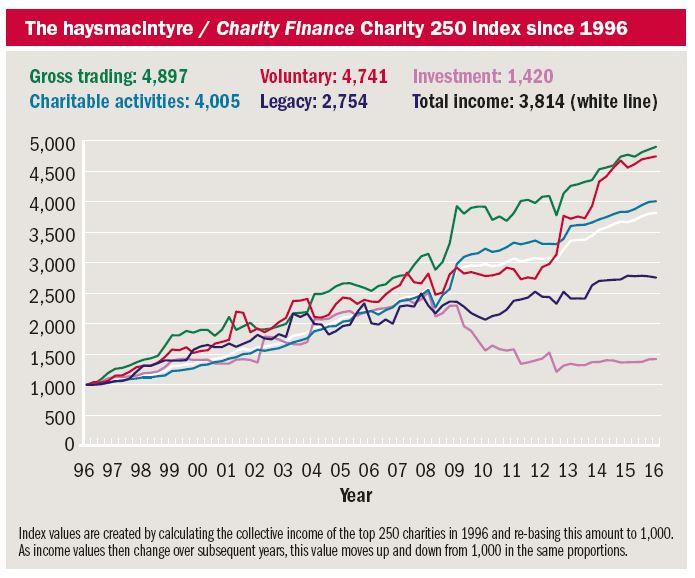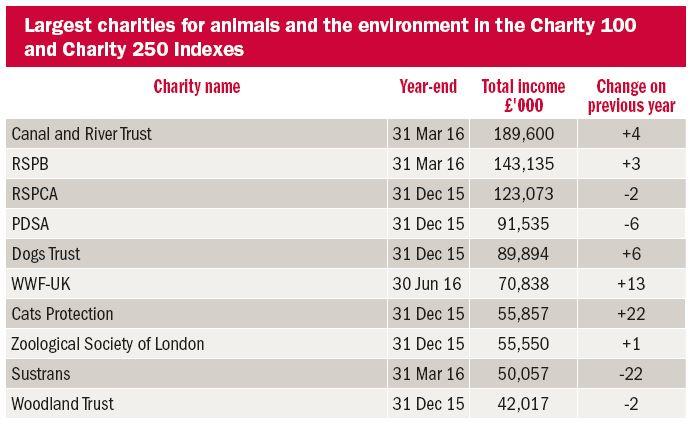The Haysmacintyre / Charity Finance Charity 250 Index performed below expectation in the quarter to 31 March 2016, marking an abrupt end to three successive quarters of above-average growth. And, as over 40 per cent of charities in the Charity 250 Index have financial year-ends falling in the first quarter, the latest figures provide a compelling indicator of income trends at UK charities in the £20m to £60m bracket.
The Charity 250 Index rose by 13 points in the first quarter of 2016, well behind its average quarterly rise of 68 points. All income streams performed below expectation, led by income from charitable activities and trading, which fell short of their quarterly benchmarks by 67 and 62 points respectively.
Some 56 per cent of Charity 250 Index charities with financial year ends falling in the first quarter report income rises in 2015/16, compared to 41 per cent reporting falls and 3 per cent reporting minimal or no change. However, a few of the income falls are very large and have clearly contributed significantly to the overall slowdown.
The biggest drop was reported by Groundwork UK, which saw its total income fall by 56 per cent to just over £5m. This resulted from a comparable fall in income from charitable activities as programmes funded by both public and private sector sources came to a close.
Its total income, which peaked at £65.9m in 2010/11, has experienced large falls each year since then, and the environmental charity is likely to exit the Charity 250 Index at the next constituent review in May.

The second largest fall in income was reported by arts venue the Wales Millennium Centre, which was down 35 per cent to £18.1m, off the back of a 33 per cent fall in income from charitable activities. The decrease partially reflects the fall-off from an exceptional 2014/15, when the performing arts venue celebrated its tenth anniversary and, according to chair Sir Emyr Jones Parry, enjoyed “the most successful commercial year in the Centre’s history.”
Measured against total income for 2013/14, the Centre’s total income for 2015/16 is still down by 7 per cent, but this was mainly due to new theatre and arts productions having yet to bring in an income.
Animal and environmental charities
Across the Charity 100 and Charity 250 Indexes there are just over 20 charities that exist for the benefit of animals and the environment. In terms of size, they range from the Canal & River Trust with annual income of £189.6 to Groundwork UK with annual income of just over £5m, though as mentioned above, the latter is likely to exit the Charity 250 Index shortly.
They also span a diverse range of sub-sectors and include charities charged with helping people care for domestic animals, such as the PDSA and Blue Cross, and charities with a broader animal welfare remit, such as the RSPCA and WWF-UK. The list also includes environmental charities such as Sustrans, which promotes sustainable transport, wildlife charities that exist to preserve native habitats such as the Wildfowl and Wetlands Trust, and research organisations such as the Pirbright Institute, which researches disease in farm animals.

Voluntary income and legacies account for the lion’s share of income at most animal welfare charities. “Animal charities are fortunate in that they enjoy broad-based support from genuine enthusiasts. However, they must also contend with the uncertainty that attends inherently discretionary income streams,” says haysmacintyre partner Adam Halsey.
Meanwhile. environmental charities such as Sustrans and the Canal & River Trust derive the bulk of their income from charitable activities in the form of grants or contract fees, while research institutes derive virtually all of their income from this source.
A striking feature of many animal charities is a heavy reliance on legacy income, which accounts for 64 per cent of income at the Donkey Sanctuary, 55 per cent at Cats Protection and 51 per cent at both the RSPCA and Blue Cross.
According to legacy data analysis firm Smee & Ford, animal charities are a top-five cause for legacy giving. However, this sector’s popularity is not growing as fast as that of others, such as faith, culture and heritage, community, and education, which accounted for almost half of charities included in a will for the first time in 2015.
There is plenty of evidence to suggest that animal charities will fight their corner when legacies are contested by disgruntled relatives. This is amply demonstrated by the Ilott v Mitson case, in which the RSPCA, RSPB and Blue Cross are challenging the decision of the courts to give part of a deceased woman’s estate to her estranged daughter against the provisions of her will.
“Charities have a legal responsibility to defend wills in which they are named as beneficiaries, but at the same time they need to ensure that the legal costs and potential reputation risks do not outweigh the benefits,” observes Halsey.

A popular cause
According to CAF’s most recent UK Giving Survey, animal charities are the third most popular cause for voluntary income (after children and young people and medical research), and received 8 per cent of all charitable donations surveyed. The survey also found that animals and environmental charities are most popular amongst the 45-64 age group.
In terms of charities that are members of the Charity 100 and Charity 250 Indexes, voluntary income accounts for 85 per cent of total income at World Animal Protection, 62 per cent at the Dogs Trust, 58 per cent at WWF-UK and 56 per cent at Battersea Dogs’ and Cats’ Home. Such charities face a range of challenges, including the requirement to comply with increasing levels of fundraising regulation, and greater competition for voluntary income from other charities looking to diversify their income streams.
While competition is a feature of this sector, so is collaboration, particularly among smaller charities. A recent case in point is Back from the Brink, a partnership between seven wildlife charities aimed at protecting more than 100 threatened species. The consortium, which earlier this year received £0.6m from the People’s Postcode Lottery, plans to launch this spring.









